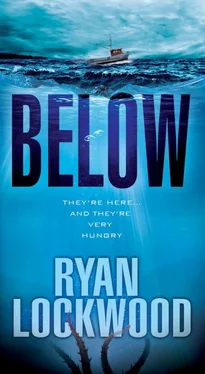Lindsay held the lead.
The knowledge that she was maintaining a faster pace than the other swimmers, compounded with the energy provided by a recent second wind, boosted her spirits and drove her forward, the other women stroking rhythmically behind her through the dark ocean swells.
Using long, measured strokes, Lindsay continued her steady pace toward the light of the charter boat ahead. The lead boat was keeping a course steady to the northeast. Lindsay couldn’t actually see the stern light, since her vision was limited to her left side, where she caught a glimpse of the moonlight reflecting off the surface of the ocean each time she raised her head to take a breath. But she could also usually see one of the two escort kayaks gliding nearby. The paddlers, wearing bright headlamps, could see the lead boat up ahead, and helped herd the swimmers into a straight path.
It didn’t matter that Lindsay’s visibility was minimal; it was too dark to see much anyway, and fog obscured the lights of the distant mainland.
Even though the few light sources around her didn’t provide much illumination, Lindsay was grateful for them. What had been the hardest for her to overcome tonight was the feeling of blindness that she dealt with every time her face was under the water, which accounted for most of the time on the swim. She could never get truly comfortable with the sensory deprivation inherent to long night swims. Years of training had at least built up her self-confidence and mental focus enough to make a swim like this manageable.
This wasn’t her first night swim, although it was her first all-night, open-water swim, a super-endurance test of twenty-one miles from Catalina Island to San Pedro, near Los Angeles. They had left Catalina Island at 11:54 P.M. with air temps in the mid-sixties and the water pushing seventy degrees. She and three other women had been swimming in the San Pedro Channel for roughly five hours, which meant the finish line was still about ten miles away.
Only the best open-water swimmers in the world attempted the all-night crossing, from a small beach in Doctor’s Cove on Catalina to the mainland. Virtually everyone crazy enough to attempt it did it at night, because of calmer seas, lighter winds, and less boat traffic. Only about a hundred and fifty swimmers had ever successfully completed the challenge.
Lindsay and the other swimmers were some of the world’s most elite open-water competitors. To even consider a swim of this nature, every one of them had been swimming in endurance-oriented, long-distance swims for years. All of them had at least one swim of over fifteen miles under her belt, and all had been swimming more than that many miles every week in the months before the race. None wore wet suits tonight, because it would rule out their acceptance into the official record books. Instead, each wore a brightly colored one-piece swimsuit that offered virtually no added buoyancy. Hers was neon green; the others had on shades of neon orange, pink, and yellow. The bright, distinct colors made it easier for escort boats to keep track of the women.
Lindsay knew the two older, more experienced German swimmers behind her had previously swum the English Channel, and were well prepared for this. But not Julie. Lindsay’s friend and longtime training partner was also swimming behind her—possibly too far behind her. Lindsay and Julie, both in their late twenties, didn’t know the older women well. The four had agreed to join for the swim after meeting over the Internet ; on a daunting swim of this distance in nighttime conditions, every added swimmer provided a boost of comfort to the others. The more contestants, however, the more complicated the efforts of the team involved. More swimmers meant a greater likelihood of separation as each set a different pace, just as Julie was now beginning to demonstrate.
A separation of the swimmers was unacceptable for safety reasons. All the women had agreed to try to stay together, and that if one of them lagged too far behind, she would concede the channel swim, allowing the charter boat to head back and pick her up. Even though they were competing with one another to some degree, this was supposed to be more about simple accomplishment. But as competitors, none of the women would give less than full effort tonight.
Lindsay had really started to worry about Julie, who was now trailing somewhere behind the other women. She could slow her pace and see if Julie could catch up, but that would mean allowing the Germans to pass her. And she didn’t want to give up a great time simply because her friend couldn’t keep up. Julie was her friend, but this wasn’t her problem. She was going to finish this. To finish strong. She felt sure of herself, her abilities. She still had plenty of energy. The escorts on the two kayaks, including Lindsay’s husband, would have to make the tough decision to pull Julie if she couldn’t go on.
Although concerned about her friend, Lindsay was elated by a recurring thought. My first channel race, and I’m leading more than halfway through it. She forced the image of winning out of her head. She still had a long way to go. It really didn’t matter if she had the “lead” now or at the end, anyway. This wasn’t a race in any sense except for a best-effort time. The ever-changing conditions of the channel—not the swimmers’ efforts—would truly dictate their final times. Lindsay was hoping for a swim under nine hours, but she realized it might take longer than twelve. She was on pace right now for a nine-and-a-half-hour swim.
Lindsay fought off the thoughts of how nice it would be to walk out of the water in San Pedro and collapse on the sand in the mid-morning sun—not to mention the satisfaction she would eventually experience from a warm bed and a hot plate of pasta. All the swimmers had eaten tonight were liquid energy shakes served in plastic bottles. Each time she treaded water with the other women and waited for the escorts to toss her next liquid meal to her, she felt like a dolphin at a marine theme park.
As Lindsay felt a large, rolling swell begin to lift her gently, she thought she saw something far below her. Some sort of dull glow. She turned her face out of the water to take a breath, then looked down into the black water through swim goggles as she exhaled. Nothing. Maybe she was starting to see things. The thought worried her.
She had to finish the swim. She couldn’t remember the last time anything had been so important.
The first time the shoal had encountered this unusual form of prey, its members had been hesitant. These animals were not a familiar food source, and were larger than the creatures they normally targeted.
But this prey had proven to be slow, awkward, harmless—and an excellent source of nourishment. Even though they were larger than most members of the shoal, they presented no threat and were vastly outnumbered.
The huge, one-eyed female accelerated toward the nearest prey, a long, flailing creature exhibiting an exciting green color. She rushed upward until several feet below the surface and then spun in the water, directing her tentacles toward the front of the animal above.
Then she attacked. Just before her tentacles closed around the bright green animal’s body, she saw its eyes widen as it flinched backward in an effort to escape.
“Come on, Julie! You gotta pick up the pace a bit.”
Bob Brunner paddled slowly and smoothly alongside his wife’s friend, hoping she could somehow find the energy to catch up with the other swimmers. They were probably sixty yards behind the other swimmers now, but he didn’t feel it was time to cut Julie off yet. There was minimal risk of separation from the others in these calm conditions, and she had trained so hard for tonight.
Bob certainly wasn’t going to judge Julie. How any of these women could swim even this far was a mystery to him. He was an active guy, who kayaked, surfed, and went running, but after an hour or so of activity he’d rather plop down in a lawn chair with a microbrew.
Читать дальше












